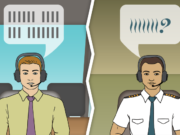
The following information provides an awareness of problems that might be avoided in the future. The information is based on final reports by official investigative authorities on aircraft accidents and incidents.
 Jets
Jets
Tension in the Cockpit
Cessna Citation 1/SP. Destroyed. Four fatalities.
During a phone call the morning of Jan. 12, 2014, the pilot was told by a flight service specialist at Trier-Fohren Airfield in Germany that “severe fog” prevailed at the airport and that visibility was not expected to improve until at least an hour after his expected time of arrival at 1230 coordinated universal time (UTC).
Beyond this phone call, there was no record that the pilot received any other weather information for the flight to Trier from Shoreham, England, according to the German Federal Bureau of Aircraft Accident Investigation (BFU).
Trier-Fohren had no published instrument approaches and thus was available only for visual flight rules (VFR) operations. Moreover, the weather conditions at the pilot’s filed alternate, Luxembourg Airport, were forecast to remain below minimums.
The report noted that the weather at Frankfurt-Hahn Airport, about 150 km (81 nm) northwest of Trier, was clear.
The Citation departed from Shoreham at 1000. It was descending from 17,000 ft to 5,000 ft at 1145 UTC when the pilot canceled the instrument flight rules portion of his flight plan and proceeded under VFR to Trier.
Investigators determined that crew coordination and situational awareness during the flight were adversely affected by tension between the pilots, resulting in part from an argument before departure that revealed the pilot’s low opinion of the copilot’s abilities and his intention not to fly with him again.
Neither pilot sought information about weather conditions at the destination or possible alternates, or established radio communication with the specialist at Trier-Fohren Airfield to obtain information about field conditions.
The pilot decided to land on Runway 22, and the Citation’s global navigation system (GPS) was programmed to provide lateral and vertical navigation guidance to that runway. Investigators later found that the vertical profile for the homemade approach likely was programmed erroneously to a target altitude below airport elevation.
The Citation was above the fog layer when it was turned to a heading corresponding with the extended centerline of Runway 22. Following the erroneous GPS vertical profile, the pilot initiated a descent into the fog at 1,400 fpm, which was twice the rate required for a three-degree glide path to the runway.
Witnesses saw the Citation emerge from the fog layer about 50 ft above the treetops before it abruptly pulled up, banked left and disappeared into the fog. “Immediately afterwards, fire had become visible and impact noises were heard,” the report said.
The BFU concluded that the pilots likely had attempted to go around after breaking through the fog layer and seeing an embankment ahead. The aircraft was in a steep climbing left turn when it struck a power pole that severed the right wing. The Citation was inverted when it then descended to the ground 2.0 nm (3.7 km) from the runway at 1235 UTC.
Too Fast, Too Long
Embraer 195. Substantial damage. No injuries.
There was no indication that the flight crew read any checklists or conducted an approach briefing as they neared Kupang, Indonesia, the afternoon of Dec. 21, 2015. Visibility at El Tari Airport was only slightly above the minimum required for the GPS approach to Runway 07.
The aircraft crossed the initial approach fix 2,000 ft high, and the enhanced ground-proximity warning system (EGPWS) then generated “high speed,” “caution terrain” and “sink rate” warnings. Nevertheless, the crew continued the approach, according to the report by the Indonesian National Transportation Safety Committee.
Despite heavy rainfall at the airport, the autobrakes had been selected to low, and the flaps remained at position 2 due to the excessive airspeed (position 5 corresponds to full flap extension).
The Embraer was on the correct glide path but crossed the runway threshold at 200 kt — about 62 kt above the reference landing speed — and touched down at the midpoint of the wet, 2,500-m (8,203-ft) runway. The aircraft overran the runway and came to a stop 200 m (656 ft) from the departure threshold. Damage was substantial, but the 125 passengers, three flight attendants and two pilots escaped injury.
Drug Impairment
Beech Premier 1. Destroyed. Two fatalities.
Shortly after departing from Fulton County Airport in Atlanta, Georgia, U.S., the night of Dec. 17, 2013, the pilot and his passenger noticed that the heat in the cabin seemed excessive. The pilot requested and received clearance to return to the airport.
“During the attempted return to the airport, possibly to resolve the cabin heat problem, the pilot was operating in a high-workload environment due to, in part, his maneuvering visually at low altitude in the traffic pattern at night, acquiring inbound traffic and being distracted by the reported high cabin temperature and multiple EGPWS alerts,” said the report by the U.S. National Transportation Safety Board (NTSB).
The EGPWS generated 11 warnings while the airplane was on the downwind leg. After the last warning to “pull up, pull up, pull up,” the pilot told his passenger, “I don’t know what that’s saying.” The Premier struck terrain shortly thereafter.
Toxicological tests revealed methylone in the pilot’s blood. “Methylone is a stimulant similar to cocaine and Ecstasy, and its effects can include relaxation, euphoria and excited calm, and it can cause acute changes in cognitive performance and impair information processing,” the report said. “The pilot’s drug impairment likely contributed to his failure to maintain control of the airplane.”
Pitot Probe Icing
Boeing 737-800s. No damage. No injuries.
The U.K. Air Accidents Investigation Branch (AAIB) found that pitot probe icing was responsible for two incidents within two days in which the flight crews of Boeing 737-800s were presented with erroneous airspeed and altitude information.
The first incident, on Jan. 8, 2016, occurred during approach in light icing conditions to land at London Gatwick Airport. “In the final stage of the approach, the airspeed and altitude returned to normal, and the aircraft landed without further incident,” the AAIB report said. “Subsequent diagnosis found the right (first officer’s) pitot probe to have a fault with its ice and rain protection heating element.”
The second incident, on Jan. 9, 2016, occurred during descent in light to moderate icing conditions to land at Liverpool Airport. This aircraft, too, was landed without further incident after the airspeed and altitude information returned to normal. Investigators found a fault in the left (commander’s) pitot probe heater.
The AAIB noted that in both cases, the pilots completed the “Airspeed and Altitude Unreliable” checklist in the quick reference handbook after the erroneous information was detected.
The incident reports also indicated that neither aircraft had been modified according to a Boeing service bulletin issued in 2014 that introduced a minor modification to the pitot probe heater wiring that generates a warning to the flight crew when a pitot heat malfunction occurs.

Turboprops
‘Operational Distraction’
Pilatus PC-12/45. Destroyed. One fatality.
Night instrument meteorological conditions (IMC) prevailed when the pilot departed from Burlington, North Carolina, U.S., the morning of Jan. 16, 2013, to transport a medical specimen to New Jersey. During initial climb, the pilot was told by air traffic control (ATC) that his transponder code was incorrect and was issued another code.
Recorded EGPWS data indicated that the PC-12 climbed to 3,300 ft and entered a descending right turn during which two “sink rate, pull up” warnings were generated. The airplane leveled out momentarily at about 1,400 ft, climbed about 600 ft and then descended to the ground about 5 nm (9 km) from the airport.
“The circumstances of the accident are consistent with the known effects of spatial disorientation,” the NTSB report said. “Although the pilot was experienced in night instrument conditions, it is possible that an attempt to reset the transponder served as an operational distraction that contributed to a breakdown in his instrument scan.”
Investigators also found an open resistor in the PC-12’s flight computer that might have caused a false indication that the autopilot was engaged. However, they were unable to determine conclusively whether the fault occurred in flight or during impact, or whether the pilot had attempted to engage the autopilot after takeoff.
Fighting the Autopilot
Saab 2000. Minor damage. No injuries.
The flight crew was conducting an instrument landing system (ILS) approach to Runway 27 at Sumburgh Airport in Scotland’s Shetland Islands the evening of Dec. 15, 2014, when they saw convective activity ahead on their weather radar display. The crew discontinued the approach and began a climbing right turn.
During the turn, the Saab was struck by lightning, which entered the radome and exited through the tail. The aircraft subsequently did not respond normally to manual nose-up pitch inputs by either pilot.
“After reaching 4,000 ft, the aircraft pitched to a minimum of 19 degrees nose-down and exceeded the applicable maximum operating speed by 80 kt, with a peak descent rate of 9,500 fpm,” the AAIB report said.
The commander applied full power at 1,100 ft, and the aircraft began to climb. The crew regained control of the Saab, diverted to Aberdeen and landed without further incident. None of the 33 occupants was injured.
The lightning strike had not directly caused the control loss. Rather, investigators determined that the autopilot was not manually disengaged after the strike occurred. The report said that the commander’s control inputs were “instinctive” and that he likely assumed that the autopilot would have disconnected when the lightning struck.
The pilots apparently did not realize that the autopilot was responding with nose-down pitch trim to counter their manual nose-up control inputs. The autopilot eventually disengaged automatically during the rapid descent.
“The pitch trim was, by this time, almost fully nose-down, and the aircraft continued to pitch nose-down and descend [although] full aft control column inputs were made,” the report said. Airspeed reached 330 kt before the crew regained control.
Investigators found that, unlike the autopilots in many other airliners, the Saab 2000’s autopilot will not disengage and will trim in the opposite direction when a pilot attempts to override it.
Based on this finding, the AAIB made several recommendations to European and U.S. authorities to review the design of autopilots in the Saab 2000 and other transport category airplanes “to ensure that the autopilot does not create a potential hazard when the flight crew applies an override force to the flight controls.”
Ditching Follows Engine Failure
Cessna 208B. Destroyed. One fatality, three serious injuries, five minor injuries.
Several passengers told investigators that they were not given a safety briefing before the Caravan departed from Kalaupapa Airport on Molokai, Hawaii, U.S., for a commuter flight to Honolulu the afternoon of Dec. 11, 2013.
The airplane was climbing through 500 ft over the ocean when the engine failed. The pilot turned back toward the airport; but, realizing that the airplane would not reach the shore, he ditched it on the ocean.
“All of the passengers and the pilot exited the airplane uneventfully,” the NTSB report said. “One passenger swam to shore, and rescue personnel recovered the pilot and the other seven passengers from the water about 80 minutes after the ditching.” However, another passenger, who was wearing a partially inflated infant life vest, had died of what an autopsy revealed as acute cardiac arrhythmia due to hyperventilation.
Although the airplane was relatively intact after the ditching, it then sank and was destroyed by ocean currents and contact with the seabed.
Investigators found that the fracture of several compressor blades had caused the loss of engine power, but they were unable to conclusively determine what had caused the blades to fracture.
The report noted that the operator of the Caravan had obtained a supplemental type certificate (STC) that increased the engine’s time between overhaul from the manufacturer’s recommended 3,600 hours to 8,000 hours.
Although the manufacturer required periodic metallurgical tests of certain compressor blades, the tests were not specifically required by the STC and had not been performed on the Caravan’s engine.
“The operator reported that the [manufacturer’s] combined guidance documentation was confusing,” the report said. “As a result, the operator did not think that the compressor turbine blade evaluation was necessary.”
 Piston Airplanes
Piston Airplanes
‘Not Thinking Straight’
Piper Chieftain. Substantial damage. No injuries.
The pilot had been awake for 15 hours when he was assigned a cargo flight from Denver, Colorado, U.S., to Colby, Kansas, the night of Jan. 21, 2015. The Chieftain was about 40 minutes into the flight when the left engine lost power, followed shortly thereafter by the right engine.
“The pilot failed to complete any of the required engine failure emergency procedures,” the NTSB report said. “He chose to perform a forced landing, during which the airplane impacted power lines and then a field” near Goodland, Kansas.
Investigators found no fuel in the fuel lines leading to the left engine and two teaspoons of fuel in the lines leading to the right engine. Each of the outboard fuel tanks contained about 35 gal (132 L) of fuel; the inboard tanks were empty.
“The pilot reported that he believed that a high level of fatigue, previous issues with another airplane he had flown that day and a recent company airplane accident had ‘caused him to not think straight and not perform the proper emergency procedures for engine failure in flight,’” the report said.
Delayed Go-Around
Piper Seneca. Destroyed. One fatality.
Visibility was at or below minimums when the pilot conducted the ILS approach to Runway 04 at Port Huron, Michigan, U.S., during a business flight the afternoon of Dec. 24, 2014.
Recorded radar data showed that the approach was not stabilized and that the Seneca was below the published decision height when it was flown over the runway, the NTSB report said. The airplane crashed in a wooded area off the departure threshold of the runway shortly after the pilot told ATC that he was conducting a missed approach.
“The wreckage path length and slope through the trees was consistent with a shallow angle of impact at relatively high speed,” the report said.
The NTSB concluded that the probable causes of the accident were “the pilot’s decision to continue flight below the minimum descent altitude without visually acquiring the runway and his delayed and improperly executed missed approach.”
Message Erased
Cessna 340. Substantial damage. No injuries.
Arriving at the airport in Coldwater, Michigan, U.S., the morning of Jan. 15, 2014, the pilot noticed blowing snow on both runways but did not see that snow banks were blocking Runway 22. He chose to land on that runway because the surface winds were from 220 degrees, according to the NTSB report.
During the landing, the 340 struck the snow banks where Runway 22 intersects Runway 07/25. The nose landing gear collapsed, causing substantial damage to the airplane’s fuselage, but the pilot was not hurt.
The report noted that the Airport/Facility Directory included a message stating that Runway 07/25 was plowed during winter months. Although this message normally was broadcast on the airport’s automated weather observation system (AWOS) frequency, “an electrical power interruption erased the message prior to the accident,” the report said.
 Helicopters
Helicopters
Deteriorating Weather
Bell 206L-4. Destroyed. Two fatalities.
Investigators found that the pilot did not obtain information about deteriorating weather conditions along the route before departing from Glendale, Arizona, U.S., for a VFR repositioning flight to Sierra Vista the afternoon of Dec. 31, 2014.
The operator’s flight data monitoring system showed that the LongRanger was flown about 200 to 300 ft above a highway before climbing to 500 ft and deviating from the track along the highway.
“It is likely that the VFR flight encountered [IMC] and the pilot was trying to maneuver to an area with greater visibility,” the NTSB report said.
The helicopter was about 29 nm (54 km) from the destination when it struck terrain in an area with 1 mi (1,600 m) visibility in fog and 500-ft ceilings.
Uncontrolled Yaw
Robinson R22. Substantial damage. One serious injury, one minor injury.
The pilot had difficulty controlling the helicopter after establishing a hover for landing at Manton Dam, Northern Territory, Australia, the morning of Jan. 19, 2013, and initiated a go-around.
Surface winds were from the west as the pilot began a steep climb at about 30 kt to clear trees. “At about 40 ft above ground level and at an airspeed of between 25 and 30 kt, the helicopter suddenly yawed to the right and completed three to four revolutions before impacting trees,” said the report by the Australian Transport Safety Bureau.
The pilot sustained minor injuries, and his passenger was seriously injured.
The report indicated that the loss of control was caused by loss of tail rotor effectiveness during the low-airspeed, high-power departure with a left crosswind.
Open-Door Distraction
Robinson R44. Minor damage. No injuries.
After completing a charter flight to a game lodge in Limpopo, South Africa, the pilot was preparing for a repositioning flight to Johannesburg the morning of Dec. 25, 2014. Shortly after he brought the R44 into a hover about 2 m (7 ft) above the ground, the right door opened.
“In an attempt to close it, the pilot allowed the helicopter’s nose to pitch up, resulting in a tail strike,” said the report by the South African Civil Aviation Authority (CAA). “Damage was limited to the lower vertical stabiliser and the tail rotor guard, and the pilot was unharmed.”
The CAA concluded that the pilot’s diverted attention — closing the door while operating the helicopter low to the ground — was the probable cause of the accident.
The report said that the accident could have been avoided if the pilot either had ensured that the door was closed prior to departure or had landed the helicopter after the door opened in flight.
| Date | Location | Aircraft Type | Aircraft Damage | Injuries |
|---|---|---|---|---|
| NA = not available
This information, gathered from various government and media sources, is subject to change as the investigations of the accidents and incidents are completed. |
||||
| Sept. 4 | Flatlands, Canada | Bell 206B | destroyed | 2 fatal, 1 minor |
| The pilot and a passenger were killed when the helicopter struck power lines and crashed in a river. | ||||
| Sept. 6 | Skopje, Macedonia | Piper Seneca | destroyed | 6 fatal |
| The Seneca struck terrain during an instrument landing system approach. | ||||
| Sept. 6 | Palm Bay, Florida, U.S. | Sikorsky S-61 | destroyed | 3 fatal |
| The S-61 was destroyed by fire after striking terrain during a post-maintenance test flight. | ||||
| Sept. 10 | Orlando, Florida, U.S. | Beech King Air 200 | substantial | 1 minor |
| Strong crosswinds prevailed when the King Air struck terrain during an attempted go-around. | ||||
| Sept. 13 | Wamena, Indonesia | Boeing 737-300F | substantial | 3 none |
| The left main landing gear collapsed when the cargo aircraft touched down hard on landing. | ||||
| Sept. 21 | Jackson, Tennessee, U.S. | Beech King Air B100 | substantial | 1 none |
| The pilot saw three green lights, but the right main landing gear was inside the wheel well when the King Air touched down. The right gear actuator was found fractured in half. | ||||
| Sept. 21 | Mineral Wells, Texas, U.S. | Piper Twin Comanche | substantial | 2 serious, 1 none |
| The pilot and a passenger were seriously injured when the airplane struck terrain short of the runway after an engine failed on final approach. | ||||
| Sept. 22 | Bray, South Africa | Beech King Air 200, Cessna 210 | substantial | none |
| The 210 failed to become airborne during an attempted takeoff and struck the King Air, which was parked at the end of the dirt airstrip. | ||||
| Sept. 24 | Bhairawa, Nepal | British Aerospace Jetstream 41 | substantial | 32 none |
| Two of the landing gear collapsed when the Jetstream overran the runway on landing. | ||||
| Sept. 25 | Jakarta, Indonesia | Learjet 31A | substantial | 8 none |
| The Learjet veered off the wet runway while landing during an emergency medical services (EMS) flight. | ||||
| Sept. 29 | Lawton, Oklahoma, U.S. | Bell 407 | substantial | 4 minor |
| The EMS helicopter was on a positioning flight when it touched down hard and struck a wall on landing. | ||||
| Sept. 30 | San Antonio de Prado, Colombia | Cessna 208B | destroyed | 4 fatal, 7 serious |
| The Caravan crashed on a hillside during an emergency landing after the engine failed on departure from Medellín for a charter flight. | ||||
| Sept. 30 | Lopez Island, Washington, U.S. | de Havilland Beaver | destroyed | 4 NA |
| All four occupants were injured when the Beaver crashed in the sea during a charter flight in marginal weather conditions. | ||||
| Oct. 1 | Taipei, Taiwan | Airbus A330-302 | substantial | 124 none |
| The A330’s rear fuselage was damaged by a tail strike during the flight crew’s initiation of a go-around after touchdown. | ||||
| Oct. 2 | Togiak, Alaska, U.S. | Cessna 208B | destroyed | 3 fatal |
| The Caravan struck a mountain about 200 ft (61 m) below the summit during a visual flight rules commuter flight. | ||||
| Oct. 9 | Uchuquinua, Peru | Cessna 207 | destroyed | 3 fatal |
| The single-engine airplane crashed in a mountainous area during a charter flight. | ||||
| Oct. 11 | Belaya Gora, Russia | Antonov 26-100 | substantial | 33 NA |
| No fatalities were reported when the An-26 struck a river bank short of the runway during an approach in heavy snow. | ||||
| Oct. 13 | Kelowna, Canada | Cessna Citation 1 | destroyed | 4 fatal |
| The Citation entered a steep descent and struck terrain shortly after takeoff. | ||||
| Oct. 13 | Smithfield, Rhode Island, U.S. | Cessna CJ3 | substantial | 6 none |
| Instrument meteorological conditions prevailed when the CJ3 overran the 5,000-ft (1,524-m) runway on landing. | ||||
| Oct. 15 | Fairoaks, England | Socata TBM-900 | substantial | 2 minor |
| The landing gear collapsed when the TBM-900 overran the runway while landing during a positioning flight. | ||||
| Oct. 23 | Baleisky, Russia | Robinson R44 | destroyed | 3 fatal |
| The R44 struck terrain under unknown circumstances. | ||||
| Oct. 24 | Luqa, Malta | Swearingen Expediter | destroyed | 5 fatal |
| The aircraft struck terrain shortly after departing for a maritime patrol flight. | ||||
| Oct. 28 | Bogotá, Colombia | Swearingen Metro 23 | substantial | 11 NA |
| No fatalities were reported when the Metro bounced three times after touchdown and veered off the runway. | ||||
| Oct. 28 | Fort Lauderdale, Florida, U.S. | McDonnell-Douglas MD-10F | substantial | 2 none |
| The freighter veered off the runway after the left main landing gear collapsed on touchdown. | ||||
| Oct. 28 | Chicago | Boeing 767-300ER | substantial | 21 minor, 149 none |
| The flight crew rejected the takeoff after the right engine failed and caught fire. Twenty-one passengers were injured during the subsequent evacuation. | ||||
| Oct. 31 | Ilaga, Papua, Indonesia | de Havilland Canada Caribou | destroyed | 4 fatal |
| The aircraft struck a mountain at about 12,000 ft during a cargo flight. | ||||



